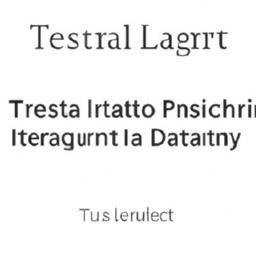In the intricate world of estate planning, legal trust documents serve as invaluable tools to protect and distribute assets according to the wishes of an individual. These meticulously crafted documents establish a fiduciary relationship in which a trustee holds and manages assets on behalf of a beneficiary. At Morgan Legal Group in New York City, we specialize in navigating the complex terrain of trusts, ensuring that our clients’ legacies are secured for future generations. Join us as we delve into the intricacies of what exactly constitutes a legal trust document and how it can benefit you and your loved ones in the long run.
Understanding the Fundamentals of a Legal Trust Document
A legal trust document is a crucial component of estate planning that outlines the distribution and management of assets held in trust for the benefit of beneficiaries. is essential for ensuring that your wishes are carried out according to your wishes. A legal trust document typically includes the following key elements:
- Trustee: The individual or institution appointed to manage the trust assets and distribute them to beneficiaries.
- Beneficiaries: The individuals or entities who will receive the trust assets according to the terms outlined in the document.
- Trust Property: The assets that are placed in the trust, such as real estate, investments, or personal property.
- Terms and Conditions: The specific instructions and conditions for how the trust assets should be managed and distributed.

Essential Components and Provisions of a Trust Document
A legal trust document is a crucial component of estate planning, providing clear guidelines for the management and distribution of assets. It serves as a legally binding agreement between the grantor (the person who establishes the trust) and the trustee (the person or entity responsible for managing the trust assets). To ensure the effectiveness and validity of a trust document, it must contain specific essential components and provisions.
Key elements to include in a trust document:
- Identification of the Parties: Clearly identify the grantor, trustee, and beneficiaries of the trust.
- Trust Property: Detail the assets, properties, or funds that are being placed into the trust.
- Trustee Powers: Outline the powers granted to the trustee for managing, investing, and distributing the trust assets.
- Distribution Instructions: Specify how and when the trust assets should be distributed to the beneficiaries.
- Revocation and Amendment: Include provisions for revoking or amending the trust document if needed.

Exploring the Benefits of Establishing a Trust
When it comes to estate planning, many individuals are turning to the creation of legal trust documents as a way to protect and manage their assets for future generations. A trust is a legal arrangement where a trustee holds assets on behalf of beneficiaries, according to the terms set out in a trust document. Establishing a trust can provide numerous benefits, including:
- Asset Protection: Trusts can protect your assets from creditors and lawsuits, ensuring they are passed on to your beneficiaries.
- Probate Avoidance: Assets held in a trust can bypass the lengthy and costly probate process, allowing your beneficiaries to receive their inheritance more quickly.
- Privacy: Unlike a will, which becomes public record upon probate, a trust allows for the distribution of assets to remain private.
Additionally, trusts can be customized to meet your specific needs and goals, whether you wish to provide for minor children, support a favorite charity, or ensure the care of a loved one with special needs. By working with an experienced estate planning attorney, such as the professionals at Morgan Legal Group in New York City, you can explore the many benefits that establishing a trust can offer to you and your loved ones.

Guidelines for Drafting an Airtight Trust Document
When it comes to drafting an airtight trust document, there are a few key guidelines that must be followed to ensure the document is legally sound and will hold up in court. The trust document is a legal agreement that outlines how assets are to be managed and distributed for the benefit of the trust’s beneficiaries. It is crucial that this document is carefully drafted to avoid any potential legal challenges in the future.
One important guideline to follow when drafting a trust document is to clearly outline the terms and conditions of the trust. This includes specifying the assets that will be placed in the trust, the beneficiaries who will receive those assets, and any conditions or restrictions on the distribution of those assets. Additionally, it is important to include provisions that address how the trust will be managed and overseen, such as appointing a trustee to oversee the trust’s administration. By clearly outlining these terms and conditions, you can help ensure that the trust document is clear and unambiguous, reducing the likelihood of misunderstandings or legal disputes down the road.
Q&A
Q: What is a legal trust document and what purpose does it serve?
A: A legal trust document is a legally binding agreement that designates a trustee to manage assets on behalf of beneficiaries. It serves to protect assets and ensure they are distributed according to the grantor’s wishes after their passing.
Q: How can a legal trust document benefit individuals and families?
A: A legal trust document can provide peace of mind by ensuring that assets are managed and distributed in a specific way, protecting beneficiaries from financial oversight or disputes. It can also offer tax benefits and avoid the lengthy probate process.
Q: What are the key components of a legal trust document?
A: The key components of a legal trust document include the names of the grantor, trustee, and beneficiaries, a description of the assets included in the trust, instructions for how the assets should be managed and distributed, and any conditions or requirements that must be met.
Q: Are legal trust documents only for the wealthy?
A: No, legal trust documents are not just for the wealthy. They can be beneficial for individuals of all income levels who want to ensure their assets are managed and distributed in a specific way. Trusts come in various forms and can be tailored to meet different needs and circumstances.
Q: How can someone create a legal trust document?
A: Creating a legal trust document typically involves working with an estate planning attorney who can draft the document based on the individual’s wishes and circumstances. It is important to carefully consider all aspects of the trust to ensure it aligns with the grantor’s intentions.
Concluding Remarks
In conclusion, a legal trust document is a powerful tool that allows individuals to protect and manage their assets for the benefit of others. By establishing a trust, you can ensure that your wishes are followed and your loved ones are taken care of long after you’re gone. Understanding the ins and outs of trust documents is essential for anyone looking to secure their financial future and provide for future generations. So, whether you’re considering creating a trust for the first time or simply want to learn more about this important legal instrument, we hope this article has provided valuable insights into the world of trust documents. Ultimately, by taking the time to educate yourself on trusts and seek the guidance of a qualified legal professional, you can feel confident in your ability to protect what matters most to you.
 What is a Legal Trust Document: Everything You Need to Know
What is a Legal Trust Document: Everything You Need to Know
A legal trust document is a vital estate planning tool that allows an individual to transfer their assets to a trust during their lifetime or upon their death. The trust document outlines the terms and conditions of the trust and designates a trustee to manage the trust assets for the benefit of the named beneficiaries. This legally binding document is an essential aspect of estate planning, providing individuals with a way to protect their assets and ensure they are distributed according to their wishes.
In this comprehensive guide, we’ll dive into the details of what a legal trust document is, how it works, and its benefits. We’ll also provide some practical tips and share some case studies and firsthand experiences to help you understand how a legal trust document can benefit you.
The Basics of a Legal Trust Document
A trust is a legal entity that is created to hold and manage assets for beneficiaries. It is created when a person (the grantor) transfers property to another person (the trustee), who manages the assets for the benefit of the beneficiaries. The trust document is the contract that outlines the terms and conditions of the trust, including instructions on how the assets should be managed and distributed.
The trust document can be created during the lifetime of the grantor, known as a living trust, or upon their death, known as a testamentary trust. A living trust can also be revocable or irrevocable, depending on whether the grantor has the power to modify or terminate the trust. On the other hand, a testamentary trust is established through a will, and its terms cannot be changed after the death of the grantor.
Types of Trusts
There are various types of trusts that can be created using a legal trust document, each with its unique purpose and benefits. Some common types of trusts include:
1. Revocable Trusts: A revocable trust can be modified or terminated by the grantor at any time during their lifetime. It allows the grantor to retain control over the trust assets and can be used as a way to avoid probate.
2. Irrevocable Trusts: Unlike a revocable trust, an irrevocable trust cannot be modified or terminated by the grantor once it is created. This type of trust offers more asset protection as the assets are no longer owned by the grantor.
3. Testamentary Trusts: As mentioned earlier, a testamentary trust is established through a will and only takes effect upon the death of the grantor. It can provide asset protection and ensure the assets are distributed according to the grantor’s wishes.
4. Special Needs Trusts: A special needs trust is designed to provide for a loved one with special needs without jeopardizing their eligibility for government benefits.
5. Spendthrift Trusts: This type of trust can be used to protect beneficiaries who may be bad with money or facing financial struggles, as it allows the trustee to control the distribution of the assets.
Benefits of a Legal Trust Document
Now that we’ve covered the basics of what a legal trust document is and the different types, let’s explore the benefits of creating one for your estate plan.
1. Probate Avoidance: One of the most significant benefits of a trust document is avoiding the lengthy and expensive probate process. Unlike assets that are passed through a will, assets held in a trust will pass directly to the designated beneficiaries without going through probate.
2. Asset Protection: By placing assets in an irrevocable trust, they are no longer considered part of the grantor’s estate, offering protection from creditors’ claims. This can be beneficial if the grantor wants to ensure their assets are protected from potential lawsuits or bankruptcy.
3. Privacy: Unlike a will, which becomes public record after the death of the grantor, a trust document allows for a more private distribution of assets. This means that the details of the trust, its terms, and the assets it contains are not available for public view.
4. Tax Planning: Trust documents can also be used as a tax planning tool. By properly structuring the trust, the grantor can minimize tax liabilities for their beneficiaries.
5. Flexibility: A trust document allows for more flexibility in the distribution of assets, as the grantor can specify the terms of the trust and how and when the assets should be distributed to the beneficiaries.
Practical Tips for Creating a Legal Trust Document
Creating a legal trust document is a complex process that should be done with the guidance of a qualified estate planning attorney. Here are some practical tips to consider when creating a trust document:
1. Choose a Trustee Wisely: The trustee is responsible for managing the assets according to the terms outlined in the trust document. It’s important to choose someone trustworthy and capable of handling the responsibilities.
2. Be Specific: When creating a trust document, it’s crucial to be as specific as possible when outlining the terms and instructions for managing and distributing the assets.
3. Review and Update Regularly: Life circumstances and laws may change over time, making it necessary to review and update your trust document regularly. This can ensure that it remains relevant and accurately reflects your wishes.
Case Studies and Firsthand Experiences
To further illustrate the importance of a legal trust document, here are some case studies and firsthand experiences:
Case Study 1: Jane had a revocable trust that she created to avoid the probate process and ensure her assets were distributed according to her wishes. However, she failed to update the trust after her husband’s passing, and her son, who was the designated beneficiary, passed away before her without updating his will. This resulted in Jane’s assets being distributed according to the state’s intestacy laws, leaving out her grandchildren.
Firsthand Experience: John created an irrevocable trust to protect his assets from potential lawsuits. One day, he was involved in a car accident, and the other driver sued him for damages. However, because his assets were held in an irrevocable trust, they were protected from the lawsuit.
In conclusion, a legal trust document is an essential aspect of estate planning that can provide numerous benefits, including privacy, asset protection, and tax planning. By understanding its basics, types, and benefits, and following practical tips, you can create a trust document that ensures your assets are managed and distributed according to your wishes. Be sure to consult with an estate planning attorney to create a trust document that meets your specific needs and goals.












